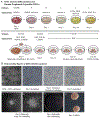Generation of esophageal organoids and organotypic raft cultures from human pluripotent stem cells
- PMID: 32586439
- PMCID: PMC8056392
- DOI: 10.1016/bs.mcb.2020.04.009
Generation of esophageal organoids and organotypic raft cultures from human pluripotent stem cells
Abstract
The human and murine esophagus have some substantial differences that limit the utility of mouse as a model to study human esophagus development and disease. Due to these limitations several recent reports describe the development of methods to generate human esophageal tissues via the directed differentiation of pluripotent stem cells. Methods for differentiation are based on knowledge of years of studying embryonic development of the esophagus in vertebrate animal models. Esophageal tissues derived from human pluripotent stem cells have been used to study both development and diseases affecting the esophagus. Here, we provide a detailed protocol for the directed differentiation of human pluripotent stem cells into human esophageal organoids and organotypic raft cultures, that are highly similar, morphologically and transcriptionally, to the human esophagus epithelium. We discuss limitations of the current esophageal models and the importance of engineering more complex tissue models with muscle and enteric nerves. Moving forward, these models might be utilized for the development of personalized treatments, as well as other therapeutic solutions.
Keywords: Anterior foregut; Definitive endoderm; Esophageal organoids; Esophageal raft cultures; Human pluripotent stem cells.
© 2020 Elsevier Inc. All rights reserved.
Figures




Similar articles
-
Generation of Gastrointestinal Organoids from Human Pluripotent Stem Cells.Methods Mol Biol. 2017;1597:167-177. doi: 10.1007/978-1-4939-6949-4_12. Methods Mol Biol. 2017. PMID: 28361317
-
Generation of human colonic organoids from human pluripotent stem cells.Methods Cell Biol. 2020;159:201-227. doi: 10.1016/bs.mcb.2020.03.001. Epub 2020 Apr 8. Methods Cell Biol. 2020. PMID: 32586443 Free PMC article.
-
Esophageal Organoids from Human Pluripotent Stem Cells Delineate Sox2 Functions during Esophageal Specification.Cell Stem Cell. 2018 Oct 4;23(4):501-515.e7. doi: 10.1016/j.stem.2018.08.008. Epub 2018 Sep 20. Cell Stem Cell. 2018. PMID: 30244869 Free PMC article.
-
The development and stem cells of the esophagus.Development. 2021 Mar 29;148(6):dev193839. doi: 10.1242/dev.193839. Development. 2021. PMID: 33782045 Free PMC article. Review.
-
Organoids from pluripotent stem cells and human tissues: When two cultures meet each other.Dev Cell. 2025 Feb 24;60(4):493-511. doi: 10.1016/j.devcel.2025.01.005. Dev Cell. 2025. PMID: 39999776 Review.
Cited by
-
Developmental basis of trachea-esophageal birth defects.Dev Biol. 2021 Sep;477:85-97. doi: 10.1016/j.ydbio.2021.05.015. Epub 2021 May 21. Dev Biol. 2021. PMID: 34023332 Free PMC article. Review.
-
Novel 3D organotypic co-culture model of pleura.PLoS One. 2022 Dec 1;17(12):e0276978. doi: 10.1371/journal.pone.0276978. eCollection 2022. PLoS One. 2022. PMID: 36454800 Free PMC article.
-
Charting human development using a multi-endodermal organ atlas and organoid models.Cell. 2021 Jun 10;184(12):3281-3298.e22. doi: 10.1016/j.cell.2021.04.028. Epub 2021 May 20. Cell. 2021. PMID: 34019796 Free PMC article.
-
Mammalian esophageal stratified tissue homeostasis is maintained distinctively by the epithelial pluripotent p63+Sox2+ and p63-Sox2+ cell populations.Cell Mol Life Sci. 2023 Sep 26;80(10):305. doi: 10.1007/s00018-023-04952-z. Cell Mol Life Sci. 2023. PMID: 37752383 Free PMC article.
-
Organotypic 3D Co-Culture of Human Pleura as a Novel In Vitro Model of Staphylococcus aureus Infection and Biofilm Development.Bioengineering (Basel). 2023 Apr 27;10(5):537. doi: 10.3390/bioengineering10050537. Bioengineering (Basel). 2023. PMID: 37237611 Free PMC article.
References
-
- Haeri H, Mardany O, Asadi-Amoli F, & Shahsiah R (2013). Human papilloma virus and esophageal squamous cell carcinoma. Acta Medica Iranica, 51 (4), 242–245. Retrieved from http://www.ncbi.nlm.nih.gov/pubmed/23690103. - PubMed
MeSH terms
Grants and funding
LinkOut - more resources
Full Text Sources
Other Literature Sources

